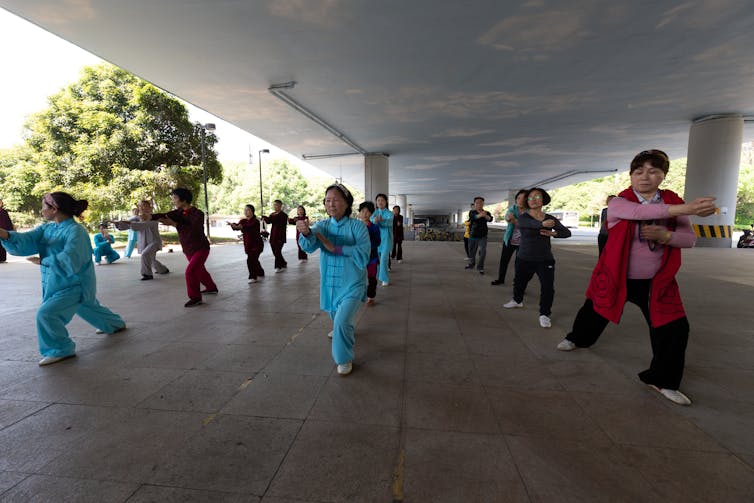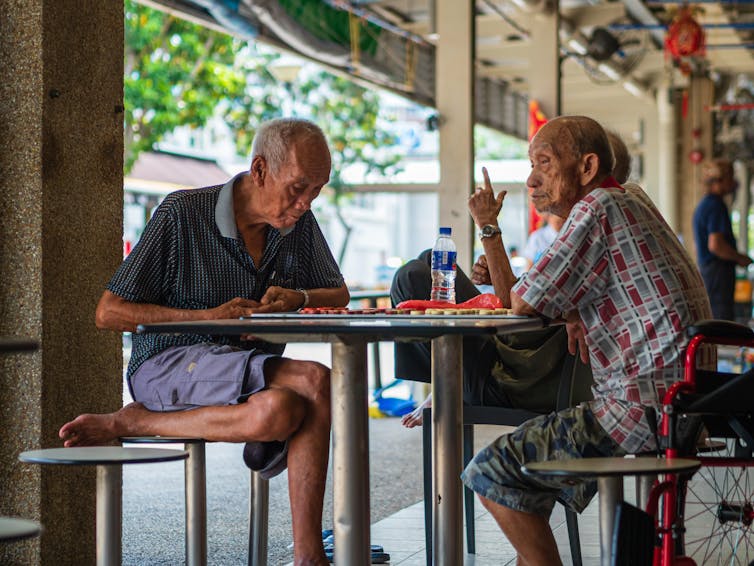Asian countries do aged care differently. Here's what we can learn from them
- Written by The Conversation
This article is part of our series on aged care. You can read the other articles in the series here[1].
Unlike in Western countries like Australia, traditional Asian cultures place a heavy emphasis on filial piety — the expectation children will support their parents in old age.
Historically, filial piety played an important role when families were large, pension schemes unavailable and life expectancy was around 50 years old.
Today, however, families in east and southeast Asia are much smaller, divorce rates and rates of non-marriage are increasing, and fewer adult children are living with their parents. These demographic shifts are nowhere more apparent than in China, Hong Kong, Japan, Singapore, South Korea and Taiwan.
Also, people are living much longer. By 2030, the UN estimates[2] 60% of the world’s older population (60+) will reside in Asia.
 Demographic changes in places like China are putting huge pressures on societies.
Shutterstock
Demographic changes in places like China are putting huge pressures on societies.
Shutterstock
Families can only do so much
In the midst of these demographic and cultural changes, Asian governments continue to promote the idea families should be primarily responsible for the care of older family members.
But for many adult children, the pressures to fulfil the demands of filial piety are immense. Those who are unable to provide care because of work demands or their own family responsibilities often find it emotionally difficult to put their parents or grandparents in institutional care.
Read more: Aged care failures show how little we value older people – and those who care for them[3]
Research has shown even hiring a live-in domestic worker is associated with negative self-esteem among adult children[4]. Care-giving for older parents can therefore become a harrowing journey requiring time, money and in-depth knowledge of the health and social care systems.
Because of these challenges — as well as the rapidly ageing populations in many Asian countries — we are being forced to think creatively about how to improve community care for older people who don’t have around-the-clock family support.
Asian countries are at the forefront of this research out of necessity. But many of these strategies can easily transfer to other parts of the world — and in some cases already are — despite any cultural differences that may exist.
Why integrated care is the way forward
The average Singaporean born in 2020 can expect to live 84.7 years, the fifth-longest life expectancy in the world[5]. By 2030, approximately one-quarter[6] of the population will be aged 65 and above.
At present, the mandatory retirement age in Singapore is 62. The old-age dependency ratio — the number of working-age people available to support one older person — has decreased from 13 in 1970 to four in 2020.
Read more: At the heart of the broken model for funding aged care is broken trust. Here's how to fix it[7]
This is why the Singaporean government has made it a priority to come up with new solutions for aged care.
One solution is the provision of integrated care[8].
Like many developed economies, aged care in Singapore has become increasingly fragmented. Today, an older person typically has specialists for each organ and may visit a general practitioner, a doctor in a polyclinic, a hospital or a traditional healer over the course of a year. None of these health records are integrated.
Thus, older people are seen as a sum of parts — and this not only affects the efficacy of their care, but also their quality of life.
The World Health Organisation has recognised the limitations of this kind of fragmented care and last year launched the Integrated Care for Older People framework[9] for countries dealing with rapidly ageing populations. This framework promotes people-centred and integrated health services for older persons via a seamless network of families, communities and health care institutions.
 Ageing in place is a strategy being embraced in Singapore.
Shutterstock
Ageing in place is a strategy being embraced in Singapore.
Shutterstock
In its ideal form, integrated care allows older people to “age in place[10]”, that is in their own homes. Older people can have their health and social care needs satisfied without having to be institutionalised, which decreases the need for government spending on institutional aged care.
Previous[11] research[12] has shown older adults who “age in place” are happier and have a higher quality of life than those in institutions.
In order to achieve an integrated care system, there has to be an alignment of goals across players in the health and social care systems.
In Singapore, this ethos has taken hold in the last decade. In 2015, the government established an Agency for Integrated Care (AIC)[13], which acts as a central repository of information for older adults and provides them with referrals and placements with health and social services.
For example, older people can be accompanied by their caregivers to the AIC to obtain referrals for dementia day care or rehabilitation services if they have injured themselves, returning to their homes in the evenings.
The idea is to provide older people with the medical and social support when they need it, but not to take them out of their communities.
Bringing nurses to residents in their communities
At the same time, community health and social care services are being ramped up and new models of care are being tested in order to achieve a truly integrated care system.
One example of a new model of care that is being piloted is a program called Care Close to Home[14] (C2H). In this model, a registered nurse and at least five nursing assistants are situated in communities and provide health and social care to residents living in the area during weekdays.
Residents are encouraged to seek help from the C2H team if, for example, they have an asthma attack or a non-serious fall. In most cases, the nurse can manage the situation.
Again, the goal of this system is to manage people’s health and social care needs at home to reduce frequent hospitalisations and entry into nursing homes.
The importance of these kinds of community health and social care services is recognised at the government level in other countries, too.
Read more: Despite more than 30 major inquiries, governments still haven't fixed aged care. Why are they getting away with it?[15]
China, for example, is currently experimenting[16] with different models of community health services to achieve an integrated care system. Japan has invested heavily[17] in the training of geriatricians and the development of community care services.
In the next decade, the models of health and social care for older adults must be re-imagined like this to support ageing populations.
Integrated care is the way forward — this is the best solution for maintaining a high quality of life among older adults. We can no longer rely on the family as the primary support system for older adults.
References
- ^ here (theconversation.com)
- ^ UN estimates (www.un.org)
- ^ Aged care failures show how little we value older people – and those who care for them (theconversation.com)
- ^ negative self-esteem among adult children (pubmed.ncbi.nlm.nih.gov)
- ^ fifth-longest life expectancy in the world (www.singstat.gov.sg)
- ^ one-quarter (www.population.sg)
- ^ At the heart of the broken model for funding aged care is broken trust. Here's how to fix it (theconversation.com)
- ^ integrated care (www.racp.edu.au)
- ^ Integrated Care for Older People framework (www.who.int)
- ^ age in place (www.nia.nih.gov)
- ^ Previous (link.springer.com)
- ^ research (academic.oup.com)
- ^ Agency for Integrated Care (AIC) (www.aic.sg)
- ^ Care Close to Home (www.duke-nus.edu.sg)
- ^ Despite more than 30 major inquiries, governments still haven't fixed aged care. Why are they getting away with it? (theconversation.com)
- ^ experimenting (www.who.int)
- ^ invested heavily (www.ijic.org)















